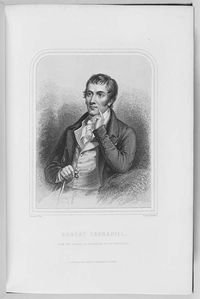Annotation:Jesse the Flower of Dunblane: Difference between revisions
No edit summary |
No edit summary |
||
| Line 3: | Line 3: | ||
<p><font face="garamond, serif" size="4"> | <p><font face="garamond, serif" size="4"> | ||
'''JESSE THE FLOWER OF DUNBLANE'''. AKA - "[[Jessie the Flower of Dunblane]]," "[[Jessy the Flower of Dunblane]]." Scottish, English; Air (6/8 time). G Major (O'Neill): D Major (Ashman, Hall & Stafford). Standard tuning (fiddle). AB (Ashman, O'Neill): AABB (Hall & Stafford). O'Neill (1922) says: "Early in the nineteenth centtury, this song was composed by a modest weaver, Robert Tannahill of Paisley, and was set to an alleged ancient Scottish melody by Robert A. Smith author of the '''Irish Minstrel''', and the '''Scottish Minstrel'''. According to Farquhar Graham, editor of Wood's '''Songs of Scotland''', not a few of the airs in the latter work were composed by Smith himself (who composed the "Jesse" air prior to 1816). Whatever the origin of the above melody may have been it has a decidedly Gaelic tonality." "Jesse the Flower of Dunblane" can also be found in '''The Union Imperial Songbook''', printed in Edinburgh by A. Hogg, J. Robertson Macreide & Co., and George Cowle & Co., London, 1815. | '''JESSE THE FLOWER OF DUNBLANE'''. AKA - "[[Jessie the Flower of Dunblane]]," "[[Jessy the Flower of Dunblane]]." Scottish, English; Air (6/8 time). G Major (O'Neill): D Major (Ashman, Hall & Stafford). Standard tuning (fiddle). AB (Ashman, O'Neill): AABB (Hall & Stafford). O'Neill (1922) says: "Early in the nineteenth centtury, this song was composed by a modest weaver, Robert Tannahill of Paisley, and was set to an alleged ancient Scottish melody by Robert A. Smith author of the '''Irish Minstrel''', and the '''Scottish Minstrel'''. According to Farquhar Graham, editor of Wood's '''Songs of Scotland''', not a few of the airs in the latter work were composed by Smith himself (who composed the "Jesse" air prior to 1816). Whatever the origin of the above melody may have been it has a decidedly Gaelic tonality." "Jesse the Flower of Dunblane" can also be found in '''The Union Imperial Songbook''', printed in Edinburgh by A. Hogg, J. Robertson Macreide & Co., and George Cowle & Co., London, 1815. | ||
[[File:tannahill.jpg|200px|thumb|left|Robert Tannahill]] | |||
<br> | <br> | ||
<br> | <br> | ||
Revision as of 03:11, 1 August 2014
Back to Jesse the Flower of Dunblane
JESSE THE FLOWER OF DUNBLANE. AKA - "Jessie the Flower of Dunblane," "Jessy the Flower of Dunblane." Scottish, English; Air (6/8 time). G Major (O'Neill): D Major (Ashman, Hall & Stafford). Standard tuning (fiddle). AB (Ashman, O'Neill): AABB (Hall & Stafford). O'Neill (1922) says: "Early in the nineteenth centtury, this song was composed by a modest weaver, Robert Tannahill of Paisley, and was set to an alleged ancient Scottish melody by Robert A. Smith author of the Irish Minstrel, and the Scottish Minstrel. According to Farquhar Graham, editor of Wood's Songs of Scotland, not a few of the airs in the latter work were composed by Smith himself (who composed the "Jesse" air prior to 1816). Whatever the origin of the above melody may have been it has a decidedly Gaelic tonality." "Jesse the Flower of Dunblane" can also be found in The Union Imperial Songbook, printed in Edinburgh by A. Hogg, J. Robertson Macreide & Co., and George Cowle & Co., London, 1815.

Br. Nicholson, writing in Notes and Queries (March 5, 1892, p. 198), recalled:
I recollect only two other occasions in which a song became immediately popular. The one was 'Jessie, the Flower of Dumblane', by Tannahill, the Paisley weaver, who was had up to London and lionized, and soon quarelled with Dr. Beattie, who composed the air, and said that the song owed all its popularity to his music, while the poet claimed it for his words. This was somewhere around the year 1816, when I was a boy of eight, and I well remember the rapid diffusion of the song; everybody seemed to be singing it, or listening to it, from royalty down to the street singer.
Sources for notated versions: copied from Wood's Songs of Scotland (Edinburgh, 1848) [O'Neill]; a c. 1837-1840 MS by Shropshire musician John Moore [Ashman].
Printed sources: Ashman (The Ironbridge Hornpipe), 1991; No. 89, p. 35. G.H. Davidson (Davidson's Gems of Scottish Melody), n.d. (c. 1830's); p. 29. Hall & Stafford (Charlton Memorial Tune Book), 1974; p. 16. O'Neill (Waifs and Strays of Gaelic Melody), 1922.
Recorded sources:
